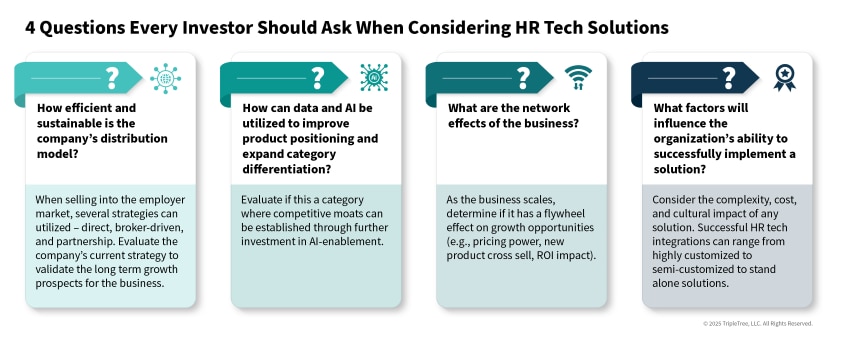
Today's HR departments are facing an environment of evolving dynamics that are forcing them to rethink their strategies and embrace technology at a rapid pace. The line between professional and personal life has blurred, and employee expectations for a seamless, consumer-grade experience are at an all-time high. This has put immense pressure on HR to move beyond traditional administrative tasks and become a strategic partner in shaping the entire employee journey.
It’s no secret that the workforce is more diverse than ever, with employees who represent different generations and backgrounds all having unique needs. Employees now expect a personalized experience, from how they're onboarded to how they manage their benefits and career development. They want easy-to-use, intuitive tools that give them control and access to information on demand.
The rise of remote and hybrid work models has also made geographical location less of a barrier. This presents both an opportunity and a challenge. HR departments need technologies that can effectively manage a globally dispersed workforce, ensuring consistent communication, compliance, and culture, regardless of where employees are located.
Companies now demand data to justify investments and measure ROI. HR leaders are using technology to gather insights on everything from employee engagement and satisfaction to turnover and productivity. This shift from a reactive to a proactive, data-driven model is a major catalyst for technology adoption. Concurrently, employees are turning to AI tools to better navigate their own healthcare journeys as employers try to keep pace with the convergence of information readily available.
 |
With a burgeoning market at the start of 2025, growth in the HR Tech sector is on the increase. Market data shows an impressive 20% year-over-year increase in global investment from Q4 ’24 to Q1 ’25, following a steady trend of optimism following a drop in investment immediately following the COVID-19 pandemic. |
TripleTree looked at some of the top trends driving investment in Employer Benefits and HR Technology and the companies leading the way.
 |
Trend #1: Benefits Personalization |
The era of "one-size-fits-all" benefits is fading. Employees now expect benefit offerings that are tailored to their unique needs, lifestyles, and life stages. This personalization requires an understanding of diverse employee demographics, fostering inclusivity and engagement.
As a result, benefits are being designed with ‘core’ offerings and further personalized by considering employees’ individual circumstances, life stage, and geographic nuances.
The key is to provide a good balance of options. According to a recent MercerMarsh report, too many options put organizations at risk of “disengaging employees, draining corporate budgets and time, and making it much harder for HR teams to prove return on significant benefits spend.”
What does this mean for companies looking to personalize?
The selection, enrollment, and administration of benefits is complex and requires more sophisticated technology solutions. Knocking at the digital front door of the benefits ecosystem, AI is being utilized to analyze employee data and suggest the most beneficial options for each individual. Naturally, these data and technology tools are extending into the voluntary benefits space, where employers are seeking to broaden their offerings as a way to attract and retain talent. For example, Corestream’s platform takes the burden off HR teams by offering a broad catalog of voluntary benefits for employees and utilizing data and technology tools to support education and enrollment in those benefits based on the unique characteristics of the individual.
Furthermore, Lifestyle Spending Accounts (LSA) are also growing in popularity. These accounts are typically funded by the employer for employees to use for a variety of expenses (e.g., childcare, commuter benefits, pet insurance, student loan repayment). A number of companies like Forma, Benepass and Thrivepass are expanding LSA offerings alongside traditional spending account solutions (e.g., Health Savings Account (HSA), Flexible Spending Account (FSA), and Health Reimbursement Arrangement (HRA)).
 |
Trend #2: Total Health and Well-Being |
Beyond traditional health insurance, there's a growing emphasis on total health and well-being, encompassing physical, mental, and financial health. 52% of employers are focused on these areas – highlighting the importance of having holistic health strategies and creating opportunities to shape connected tech-enabled solutions.
Within those areas, mental health is increasingly recognized as critical to overall well-being, impacting productivity, attendance, and retention – with companies offering a growing number of technology solutions to support employees.
For example, Employee Assistance Program (EAP) offerings have long been a cornerstone of an employer’s approach to supporting mental health and wellness. Now employers are asking more of their EAP providers – including the integration of technology-enabled solutions and services. The market has taken note, and providers are actively investing to meet the challenge.
Lyra, Spring Health, and Modern Health are bringing virtual-first solutions to the market by addressing important mental health needs through platforms that leverage robust user experiences and offer innovative virtual engagement. To do this, these solutions have broad networks and utilize AI for personalized provider matching to speed access to care and support self-care guidance.
Platforms such as Telus Health, Compsych, and Curalinc Healthcare are addressing the market with a broad suite of services that span mental health, financial wellness, and organizational performance to act as a holistic provider to support the long-term productivity of an employer’s workforce.
 |
Trend #3: Affordability & Access |
Employers are being forced to consider more creative options to improve access to their benefits and manage their own costs and the employees out of pocket, in a way that doesn’t just continue to shift costs onto the employee.
Shifts towards high-deductible plans, consumer shopping, and benefit accounts have long been a staple in managing both plan and employee costs. However, data is now being utilized and incorporated into benefit plan designs to both manage costs and enhance consumer intelligence in selecting the care they need.
This has given rise to transparent, variable co-pay models that reward employees for making good healthcare decisions that consider the cost and quality of care they are seeking. Companies such as Garner Health and Valenz Health are analyzing broad data sets to evaluate provider quality and present the best options to an individual based on their specific need.
Virtual care options are being implemented to lower the overall unit cost of seeking care and present employees with a digital first option so they can access conveniently.
Revive Health has built a platform that acts as a virtual clinic for employees to access not only primary care and mental health support, but also prescriptions and nutritional coaching.
With these trends in mind, the need for investors to evaluate opportunities through a holistic lens has never been more critical.

Navigating Tomorrow: Technology Ushers in New Era of HR and Benefits Excellence
The complex HR landscape, punctuated by evolving employee expectations, is becoming more dynamic and personalized, reflecting societal shifts towards health, flexibility, and sustainability. By proactively understanding and adapting to these trends, HR leaders can not only attract and retain talent but also cultivate a workplace where employees truly thrive both professionally and personally. Leveraging technology will be key to managing and personalizing these offerings effectively, ensuring organizations are partners in their employees' life journeys.
At TripleTree, we’ll continue to provide insights about how technology is transforming the way in which HR professionals, investors, and other healthcare stakeholders are advancing holistic well-being solutions to meet the ever-changing expectations of today’s employees. Read more about how technology is transforming the healthcare landscape in these previous TripleTree publications or reach out for more information.
The Climb of Digital Health Solutions for Healthier Future
Trendwatch 2025: What's Ahead in Healthcare
Trendwatch 2024: A More Holistic, Longitudinal, and Personalized Healthcare System



